A | B | C | D | E | F | G | H | CH | I | J | K | L | M | N | O | P | Q | R | S | T | U | V | W | X | Y | Z | 0 | 1 | 2 | 3 | 4 | 5 | 6 | 7 | 8 | 9
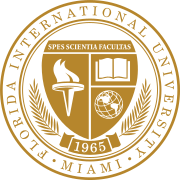 | |
| Motto | Spes Scientia Facultas (Latin) |
|---|---|
Motto in English | "Hope, Knowledge, Opportunity" |
| Type | Public research university |
| Established | 1965 |
| Founder | Florida Legislature |
Parent institution | State University System of Florida |
| Accreditation | SACS |
Academic affiliations | |
| Endowment | $276 million (2022) |
| Budget | $1.7 billion (2021)[1] |
| President | Kenneth A. Jessell[2] |
| Provost | Elizabeth M. Bejar[3] |
Academic staff | 7,665 (2021) |
Administrative staff | 9,856 (2017) |
| Students | 55,687 (fall 2022) |
| Undergraduates | 45,442 (fall 2022) |
| Postgraduates | 10,244 (fall 2022) |
| Location | , , United States 25°45′25″N 80°22′26″W / 25.757°N 80.374°W |
| Campus | Large Suburb[6], 587.1 acres (237.6 ha)[4][5] |
| Other campus and centers[7] | Other Campus North Miami (Biscayne Bay Campus) Centers
|
| Newspaper | PantherNOW |
| Colors | Blue and gold[8] |
| Nickname | Panthers |
Sporting affiliations | |
| Mascot | Roary The Panther |
| Website | www |
Florida International University (FIU) is a public research university with its main campus in University Park, Florida. Founded in 1965 by the Florida Legislature, the school opened its doors to students in 1972. FIU has grown to become the third-largest university in Florida and the eighth-largest public university in the United States by enrollment.[9][10] FIU is a constituent part of the State University System of Florida.
The university is classified among the Carnegie "R1: Doctoral Universities – Very high research activity" institutions.[11] FIU has 11 colleges and more than 40 centers, facilities, labs, and institutes that offer more than 200 programs of study.[12] It has an annual budget of over $1.7 billion and an annual economic impact of over $5 billion.[13] The university is accredited by the Southern Association of Colleges and Schools (SACS).
FIU's intercollegiate sports teams, the FIU Panthers, compete in National Collegiate Athletic Association (NCAA) Division I and the Conference USA (C-USA). FIU's varsity sports teams have won five athletic championships and Panther athletes have won various individual NCAA national championships. Kenneth A. Jessell has served as President of FIU since 2022.[14]
History
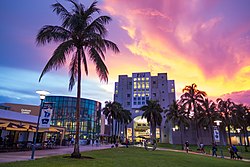
In 1943, state senator Ernest 'Cap' Graham (father of future Florida governor and U.S. senator Bob Graham) presented the state legislature with the initial proposal for the establishment of a public university in Miami-Dade County.[15] While his bill did not pass, Graham persisted in presenting his proposal to colleagues, advising them of the county's need for a state university. He felt the establishment of a public university was necessary to serve the city's growing population.[16]
In 1964, Senate Bill 711 was introduced by Florida senator Robert M. Haverfield.[17] It instructed the state Board of Education and the Board of Regents to begin planning for the development of the state university. The bill was signed into law by then-governor W. Haydon Burns in June 1965.[15]
FIU's founding president Charles "Chuck" Perry was appointed by the board of regents in July 1969, at which time the institution was named Florida International University.[18] At 32 years old, the new president was the youngest in the history of the State University System[19] and, at the time, the youngest university president in the country. Perry recruited three co-founders, Butler Waugh, Donald McDowell and Nick Sileo. Alvah Chapman, Jr., former Miami Herald publisher and Knight Ridder chairman, used his civic standing and media power to assist the effort. In the 1980s, Chapman became chair of the FIU Foundation Board of Trustees.[16]
The founders located the campus on the site of the original Tamiami Airport (not related to the later Kendall-Tamiami Airport) on the Tamiami Trail (U.S. Route 41) between Southwest 107th and 117th Avenues, just east of where the West Dade Expressway (now the Homestead Extension of Florida's Turnpike) was being planned.[18] The abandoned airport's air traffic control tower became FIU's first building, with Perry's office on the first floor.[20][21] It originally had no telephones, no drinking water, and no furniture. Perry decided that the tower should never be destroyed, and it remains on campus, where it is now known variously as the "Veterans Office," "Ivory Tower," the "Tower Building," or the "Public Safety Tower," and is the former location of the FIU Police Department.
Groundbreaking for the Tamiami campus was held in January 1971. U Thant received FIU's first honorary degree.[22]
Miami-Dade County's public university

In September 1972, 5,667 students entered the new state university, the largest opening day enrollment at the time. Eighty percent of the student body had just graduated from Dade County Junior College (now Miami-Dade College). A typical student entering FIU was 25 years old and attending school full-time while holding down a full-time job. Forty-three percent were married. Negotiations with the University of Miami and Dade County Junior College led FIU to open as an upper-division only school; Perry's vision foresaw a "no gimmicks" institution with no student housing.[24] It would be nine years before lower-division classes were added.[16]
The first commencement, held in June 1973, took place in the reading room of the ground floor of Primera Casa – the only place large enough on campus for the ceremony. More than 1,500 family members and friends watched FIU's first class of 191 graduates receive their diplomas.[16]
By late 1975, after seven years at the helm, Charles Perry felt he had accomplished his goal and left the university to become president and publisher of the Sunday newspaper magazine Family Weekly (later USA Weekend), one of the country's largest magazines. When he left, there were more than 10,000 students attending classes and a campus with five major buildings and a sixth being planned.[16]
Crosby and Wolfe: 1976–1986
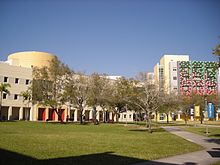
Harold Crosby, the university's second president and the founding president of the University of West Florida in Pensacola, agreed in 1976 to serve a three-year "interim" term. Under his leadership, FIU's North Miami Campus (which was officially renamed the Bay Vista Campus in 1980, the North Miami Campus in 1987,[25] the North Campus in 1994, and the Biscayne Bay Campus in 2000)—located on the former Interama site on Biscayne Bay—was opened in 1977. State senator Jack Gordon was instrumental in securing funding for the development of the campus. President Crosby emphasized the university's international character, prompting the launching of new programs with an international focus and the recruitment of faculty from the Caribbean and Latin America. President Crosby's resignation in January 1979 triggered the search for a "permanent" president.[26]
Gregory Baker Wolfe, a former United States diplomat and then-president of Portland State University, became FIU's third president, serving from 1979 to 1986. During his tenure, the institution continued to grow; it became a four-year institution, though Wolfe was criticized for not hiring enough minorities and for leading a weak private fundraising effort.[27] After stepping down as president, Wolfe taught in the university's international relations department. The student union on the Biscayne Bay Campus is named in his honor.[26]
Maidique presidency and expansion


Modesto A. Maidique assumed the presidency at FIU in 1986, becoming the fourth in the university's history and the first Hispanic leader of any of Florida's state universities.[28] Maidique graduated with a Bachelor of Science, Master of Science, and PhD in Electrical Engineering from Massachusetts Institute of Technology (MIT), before joining the private sector. He held academic appointments from MIT, Harvard and Stanford Universities, and has been named to several US presidential boards and committees.[29]
Under his leadership, FIU heralded in an era of unprecedented growth and prestige, with all facets of the university undergoing major transformations. Physically, the university tripled in size and its enrollment grew to nearly 40,000. During his 23 years as president, the school established the Herbert Wertheim College of Medicine, the FIU College of Law, the FIU School of Architecture, and the Robert Stempel School of Public Health. Also during his tenure, the endowment grew from less than $2 million to over $100 million.[30]
During Maidique's tenure, the university added 22 new doctoral programs. Research expenditures grew from about $6 million to nearly $110 million as defined by the National Science Foundation.[31] In 2000, FIU attained the highest ranking in the Carnegie Foundation classification system, that of "Doctoral/Research University-Extensive."[32] FIU's faculty has engaged in research and holds far-reaching expertise in reducing morbidity and mortality from cancer, HIV/AIDS, substance abuse, diabetes and other diseases, and change the approaches to the delivery of health care by medical, public health, nursing and other healthcare professionals, hurricane mitigation, climate change, nano-technologies, forensic sciences, and the development of biomedical devices.
The arts also flourished while Maidique was at the helm, with the university acquiring The Wolfsonian-FIU Museum on Miami Beach and building the Patricia and Phillip Frost Art Museum on its main campus. In athletics, FIU made inroads in becoming a powerhouse athletic university during Maidique's time as president; he unilaterally changed the mascot from the Sunblazers to the Golden Panthers early in his tenure,[33] and he championed the eventual establishment of an NCAA football program. Finally, the school earned membership into Phi Beta Kappa, the nation's oldest honor society.[34]
Maidique was the second longest-serving research university president in the nation.[31] Now President Emeritus, he currently serves as the Alvah H. Chapman, Jr., Eminent Scholar Chair in Leadership, and Professor of Management at FIU.
Rosenberg presidency

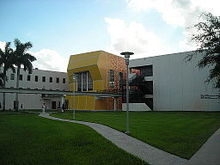
On November 14, 2008, Maidique announced that he would be stepping down and asked FIU's board of trustees to begin the search of a new president. He said he would remain president until a new one was found.[35] On April 25, 2009, Mark B. Rosenberg was selected to become FIU's fifth president. He signed a five-year contract with the board of trustees.[36] On August 29, 2009, Rosenberg became FIU's fifth president.[37]

Having started as a two-year upper division university, FIU has grown into a much larger traditional university and serves international students. More than $600 million has been invested in campus construction, with the addition of new residence halls, the FIU Stadium, recreation center, student center, and Greek life mansions, as well as the fielding of the Division I-A Golden Panthers football team in 2002.[38]
Since 1986, the university established its School of Architecture, College of Law and College of Medicine (named the Herbert Wertheim College of Medicine in 1999 after Herbert Wertheim donated $20 million to the college, which was matched by state funds and is the largest donation in the university's history),[39] and acquired the historic Wolfsonian-FIU Museum in Miami Beach.[40][41]
FIU now emphasizes research as a major component of its mission and is now classed as a "very high research activity" university under the Carnegie Classification of Institutions of Higher Education. Sponsored research funding (grants and contracts) from external sources for the year 2007–2008 totaled some $110 million. FIU has a budget of over $649 million.[10] The Florida International University School of Hospitality & Tourism Management collaborated with the Ministry of Education of the People's Republic of China to work on preparations for the 2008 Summer Olympics. FIU was the only university in the United States invited to do so.[42][43]
In December 2013, it was announced Royal Caribbean was building a $20 million 130,000 sq. ft. training facility for its performers at the school.[44] The facility opened in March 2015.[45] The complex serves architecture, art, and hospitality students and includes lighting, set design, marketing, and other internship and training opportunities.[44][46]
On March 15, 2018, a newly constructed pedestrian bridge collapsed outside the university, resulting in six fatalities.[47] On May 6, 2020, Florida Department of Transportation announced plans to design and rebuild the bridge.
Rosenberg suddenly resigned from the university effective January 21, 2022, citing deteriorating health conditions of his wife. Just a week later it was revealed that he stepped down because of allegations that he had made advances to a younger female employee, "causing discomfort," and creating a hostile work environment.[48] Rosenberg is currently a professor of political science and international relations at the Steven J. Green School of International and Public Affairs at FIU.[49]
Jessell presidency
Rosenberg was succeeded by Kenneth A. Jessell as president, previously FIU's chief financial officer and senior vice president for finance and administration.[50] Jessell was selected as FIU's sixth president on October 17, 2022 by FIU's board of trustees and was confirmed by the Florida Board of Governors on November 9, 2022.[14][51]
Campus


Florida International's 344-acre (139 ha) campus is in the neighborhood of University Park in the census-designated place of Westchester in an unincorporated area of western Miami-Dade County, Florida. The Modesto A. Maidique Campus ("MMC")—formerly called University Park but renamed in 2009[52]—encompasses 344 acres (1.39 km2). The MMC houses almost all of the university's colleges and schools as well as all the administrative offices and main university facilities. MMC is also home to the Ronald Reagan Presidential House, the home of FIU's president; the Wertheim Performing Arts Center; the Frost Art Museum; the International Hurricane Research Center; and the university's athletic facilities such as FIU Stadium, FIU Arena, and the FIU Baseball Stadium.
The postal address of the Modesto Maidique campus is designated as being of "Miami, Florida" and the ZIP code is 33199, while the campus is physically in the Westchester census-designated place as of the 2020 U.S. Census.[53] In the 1990 U.S. Census it was in the Olympia Heights CDP.[54] In the 2000 U.S. Census and the 2010 U.S. Census this campus was in the University Park CDP.[55][56]
The site of the campus was originally used for a general aviation airport called Tamiami Airport (not to be confused with Kendall-Tamiami Airport), which was in operation from the 1940s until 1967, when it relocated to a new site.[57] The airport had three runways and was used for pilot training, among other purposes.[58] The original campus was named the Tamiami Campus, after the nearby Tamiami Trail highway and the former airport, until being designated the University Park Campus in 1987.[25]
Until the early 1990s, the runways, parking ramp, and other features of Tamiami Airport were still visible on campus and clearly discernible in aerial photos.[58] Construction has removed all of these features, and only the University Tower remains as a memory of the university's past.[59] University Park is a heavily vegetated campus, with many lakes, a 15-acre nature preserve, and a palm arboretum, with over 90 buildings. As of late 2009, current construction at University Park includes the Nursing and Health Sciences Building, the School of International and Public Affairs Building, and a fifth parking garage.[60]
On June 12, 2009, FIU's board of trustees voted unanimously to rename the University Park campus to the Modesto Maidique Campus; the university had considered naming the law school in his honor but decided not to because that would preclude a future charitable donation to name the school.[52] The change created a large backlash from the FIU community, as many felt it unfitting to name the campus after him. A campaign by FIU students and alumni was created to revert the name change, and to keep the name University Park. A Facebook group, "No to Maidique's Campus" with over 2,000 supporters has made national news, in many newspapers, TV news stations, and collegiate magazines, supporting to keep the name "University Park".[61]
Engineering Center
Located five blocks north of Modesto A. Maidique, is the 38-acre (15.3 ha) Engineering Center which houses a part of the College of Engineering and Computing and is the home of FIU's Motorola Nanofabrication Research Facility. The Engineering Center is serviced by the CATS Shuttle, FIU's student buses, which run throughout the day on weekdays connecting the two parts of campus.[62]
Main Modesto A. Maidique buildings
|
|
|
Carlos Finlay Elementary School, of the Miami-Dade County Public Schools, is on the FIU Maidique Campus.[65] The National Weather Service Miami Office is also on FIU property. Both Finlay ES and the Hurricane Center are subleased.[66]
Biscayne Bay Campus

The Biscayne Bay Campus (BBC) in North Miami is Florida International's 200-acre (91 ha) waterfront branch campus. It was opened in 1977 by Harold Crosby and occupies land, directly on the bay and adjacent to the Oleta River State Park, with which FIU has a research partnership. Access to these resources inspired the creation of a marine biology program on the Biscayne Bay Campus, which has become one of the university's most recognized programs. The Biscayne Bay Campus also houses the School of Hospitality & Tourism Management,[67] the School of Journalism and Mass Communication, the Aquatic Center, and the Kovens Conference Center. The Golden Panther Express, FIU's student buses, connect the main campus and the Biscayne Bay Campus throughout the day on weekdays.[68]
On the Biscayne Bay Campus, FIU offers housing through Bayview Student Living apartments. BBC's first on-campus new housing in 30+ years houses 408 students in a high rise overlooking Biscayne Bay.[40][69] Through FIU's Panther Express Shuttle, current students travel free between campuses.
Regional centers
FIU also has other smaller regional centers located throughout South Florida in both Miami-Dade County and Broward County, serving the local communities in research, continuing studies, and in culture. In Miami-Dade County, there are four regional FIU facilities, the Downtown Miami Center, the Wolfsonian-FIU Museum in Miami Beach (Washington Avenue and 10th St), the FIU-Florida Memorial research center in Miami Gardens, and a research site in Homestead.
FIU at I-75
The FIU at I-75 academic center is a satellite campus located in Miramar, which borders Pembroke Pines and the southernmost portion of Interstate 75 in Broward County. It finished construction in 2014 and is used to satisfy overwhelming demand from Broward County students.[70] The campus houses an 89,000-sqft. complex that offers programs offers courses and program from within the College of Arts & Sciences, College of Business, College of Education, and the College of Engineering & Computing. This campus is also equipped with offices, a computer lab, student lounges, and study spaces for students.
Downtown Miami Center
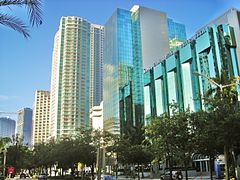
FIU has a center on Brickell Avenue in Downtown Miami at 1101 Brickell Avenue dubbed "FIU Downtown on Brickell". FIU's College of Business Administration has had classes at the Burdines Building on Flagler Street and the Metropolitan Center had offices at 150 SE 2nd Ave since 2004. In August 2011, FIU expanded its Downtown center to 1101 Brickell with the expansion of course offerings for the College of Business Administration and the School of International and Public Affairs, as well as with FIU's research center, the Metropolitan Center. Most programs in Downtown are graduate-level evening courses geared for Downtown professionals and residents.[71] As of Spring 2011, there were approximately 500 students enrolled at the Downtown center, with plans to grow the center to over 2,000 students by 2021.[72]
Global Forensic and Justice Center, Largo
Founded in 2018, it combines two decades of experience to engage the forensic science and criminal justice industries from the crime scene to the courtroom. Located at: Bryan Dairy Road, Largo, Florida . [73]
Organization and administration
FIU belongs to the 12-campus State University System of Florida and is one of Florida's primary graduate research universities, awarding over 3,400 graduate and professional degrees annually.[74] The university offers 191 programs of study with more than 280 majors in 23 colleges and schools. FIU offers many graduate programs, including architecture, business administration, engineering, law, and medicine, offering 81 master's degrees, 34 doctoral degrees, and 3 professional degrees.[75]
Student government
The Student Government Association presides over and funds the over 300 student clubs, organizations, and honor societies at the university and has an operating budget of about $20 million each year.[76] The Student Government Association is split into three branches. The Executive branch consists of the Student Body President and Vice President, who are chosen in a university-wide election, and well as the Governor of the Biscayne Bay Campus, who is chosen in an election of students pertaining to that campus. The Executive branch also contains the Cabinet of the Student Body President. The Legislative branch consists of the Student Body Senate. The Judicial branch consists of the Supreme Court. The Student Body President serves as a member of the FIU Board of Trustees, while the Student Body Vice President serves as a member of the FIU Foundation's Board of Directors.
The Student Government oversees several Agencies which provide programming to the student body: the Homecoming Council, the Student Programming Council, Panther Power, and the Registered Student Organizations Council, which is responsible for registering the over 300 student organizations and distributing funding allocated by the Student Government. Panther Power is the student spirit group,[77] and it can be seen in all FIU athletic events alongside the Band, the Dazzlers dance team, and the cheerleaders.[78] In addition, the Student Government oversees several Bureaus which provide community for identity groups on campus, including the Black Student Union and the Pride Student Union.
Presidents
| President[79] | Tenure |
|---|---|
| Charles Perry | 1965–1976 |
| Harold B. Crosby | 1976–1979 |
| Gregory Baker Wolfe | 1979–1986 |
| Modesto A. Maidique | 1986–2009 |
| Mark B. Rosenberg | 2009–2022 |
| Kenneth A. Jessell | 2022– |
Colleges and Schools
|
|
Academics

FIU offers 191 academic programs, 60 baccalaureate programs, 81 master's programs, 3 specialist programs, 34 doctoral programs, and 4 professional programs in 23 colleges and schools. In addition, 97% of the faculty have terminal degrees, and 50% currently have tenure at the university with a student/teacher ratio of 27:1.[85][86]
In the early 2000s (decade), emphasis at FIU was placed on growth in degree programs and student enrollment. Since 2005 however, student enrollment has been capped and emphasis became placed on improving the quality of the existing academic programs. With the addition of the College of Medicine, the demand for facilities and classroom space has greatly increased.[87]
Tuition
For the 2019–2020 academic year, tuition costs are:
- Undergraduate
- $205.57 per credit hour for in-state students, and $618.87 per credit hour for out-of-state students.[88] Total tuition/fees :$7,916 for in-state and $20,314 for out of state[88]
- Graduate
- $455.64 per credit hour for in-state students, and $1,001.69 per credit hour for out-of-state students.[89] Total tuition/fees :$9,600 for in-state and $19,428 for out of state[89]
- Law School (day)
- $675.67 per credit hour for in-state students, and $1,101.87 per credit hour for out-of-state students.[89] Total tuition/fees:$20,660 for in-state and $33,446 for out of state[89]
- Law School (night)
- $506.77 per credit hour for in-state students, and $851.40 per credit hour for out-of-state students.[89] Total tuition/fees:$15,593 for in-state and $25,932 for out of state[89]
Admissions
| 2022[90] | 2021[91] | 2020[92] | 2019[93] | 2018[94] | 2017[95] | |
|---|---|---|---|---|---|---|
| Applicants | 17,343 | 16,406 | 16,911 | 18,492 | 19,410 | 14,861 |
| Admits | 11,075 | 10,502 | 9,784 | 10,634 | 11,366 | 7,596 |
| Enrolls | 4,424 | 4,061 | 3,763 | 3,998 | 4,441 | 2,895 |
| Admit rate | 63.9% | 64.0% | 57.9% | 57.5% | 58.6% | 51.1% |
| Yield rate | 39.9% | 38.7% | 38.5% | 37.6% | 39.1% | 38.1% |
| SAT composite* | 1070–1240 (90%†) |
1030–1220 (87%†) |
1110–1260 (92%†) |
1110–1280 (92%†) |
1090–1260 (77%†) |
1100–1260 (71%†) |
| ACT composite* | 21–26 (10%†) |
21–27 (13%†) |
23–29 (8%†) |
23–28 (8%†) |
23–27 (23%†) |
23–27 (29%†) |
| * middle 50% range † percentage of first-time freshmen who chose to submit | ||||||
Florida International University students, numbering 56,592 in Fall 2021, come from more than 130 countries, and all 50 U.S. states. The ratio of women to men is 57:43, and 28.9 percent are graduate and professional students. Professional degree programs include Law, Medicine, Engineering, Business Administration, and Nursing.
The Fall 2021 incoming freshman class had an average 4.34 GPA, 1338 SAT score, and a 28.66 ACT score. The freshman retention rate for 2021 was 100%. The most popular College by enrollment is the College of Arts and Sciences.[96]
For Fall 2021, 24,351 students applied for graduate admissions throughout the university. Of those, 8,043 (33.02%) were accepted. The Wertheim College of Medicine admitted 5.2% of its applicants, and the College of Law admitted 22%. Admission to the Wertheim College of Medicine is competitive, and the college has one of the highest number of applicants in the state, greater than the University of Florida. For Fall 2010, 3,606 students applied for 43 spots.[97]
The FIU School of Architecture is the most competitive in Florida, with the lowest admission rate in the state at 14% (2011).[98] For Fall 2009, the School of Architecture received over 1,000 applications for the first-year Master of Architecture program, with 60 being accepted, giving the School of Architecture a 6% admissions rate. The average high school GPA for the freshman class in the School of Architecture was 3.98, also making it one of the most selective schools at FIU.[99]
Enrollment
| Academic Year | Undergraduates | Graduate | Total Enrollment |
|---|---|---|---|
| 2017–2018[95] | 47,586 | 9,265 | 56,851 |
| 2018–2019[94] | 48,439 | 9,625 | 58,064 |
| 2019–2020[93] | 49,004 | 9,823 | 58,827 |
| 2020–2021[92] | 48,664 | 10,235 | 58,899 |
| 2021–2022[91] | 46,079 | 10,653 | 56,732 |
| 2022–2023[90] | 45,442 | 10,245 | Zdroj:https://en.wikipedia.org?pojem=Florida_International_University

